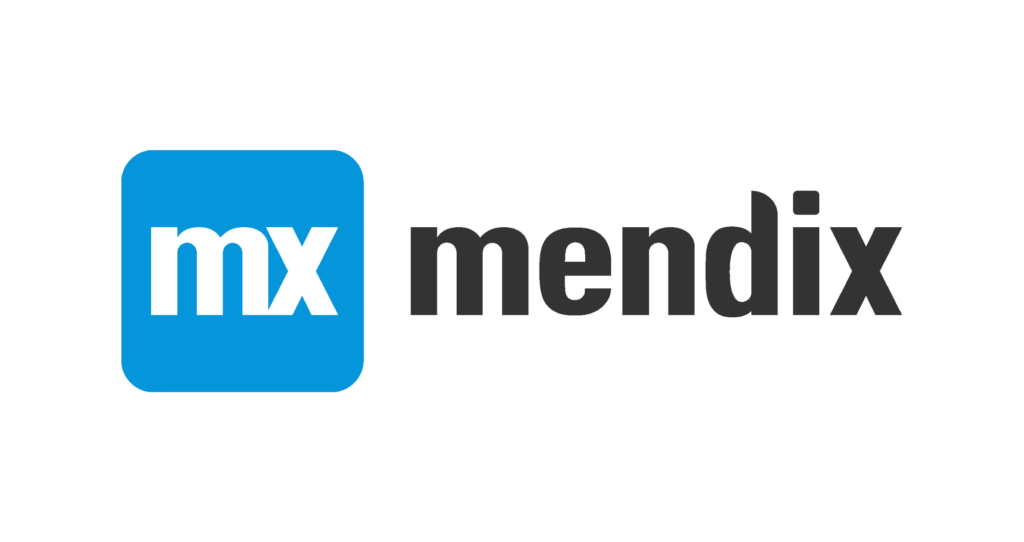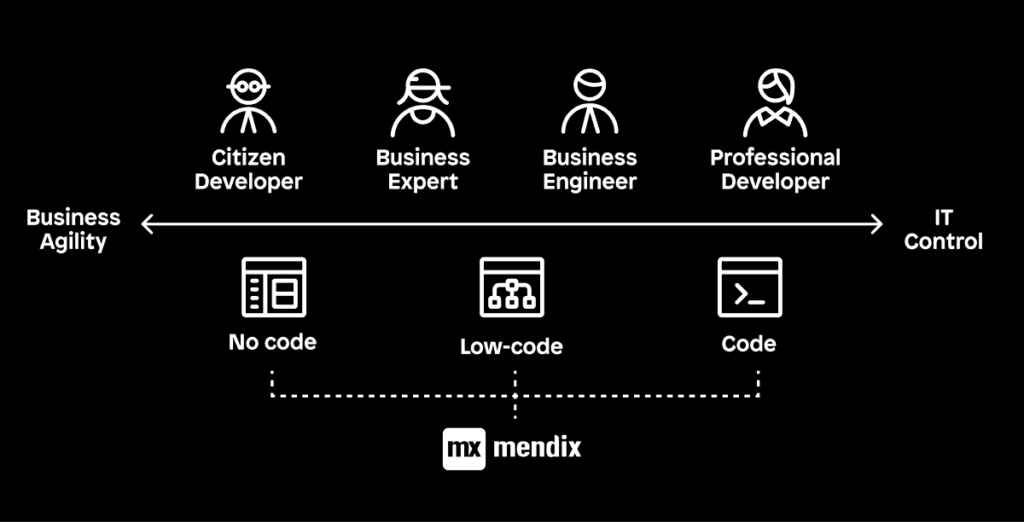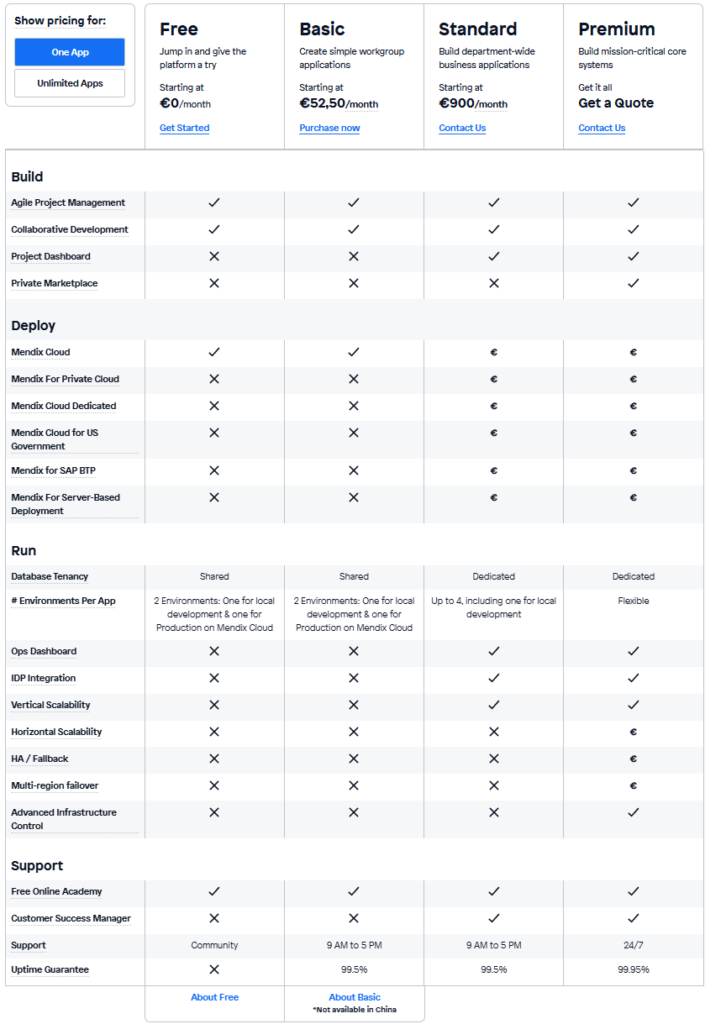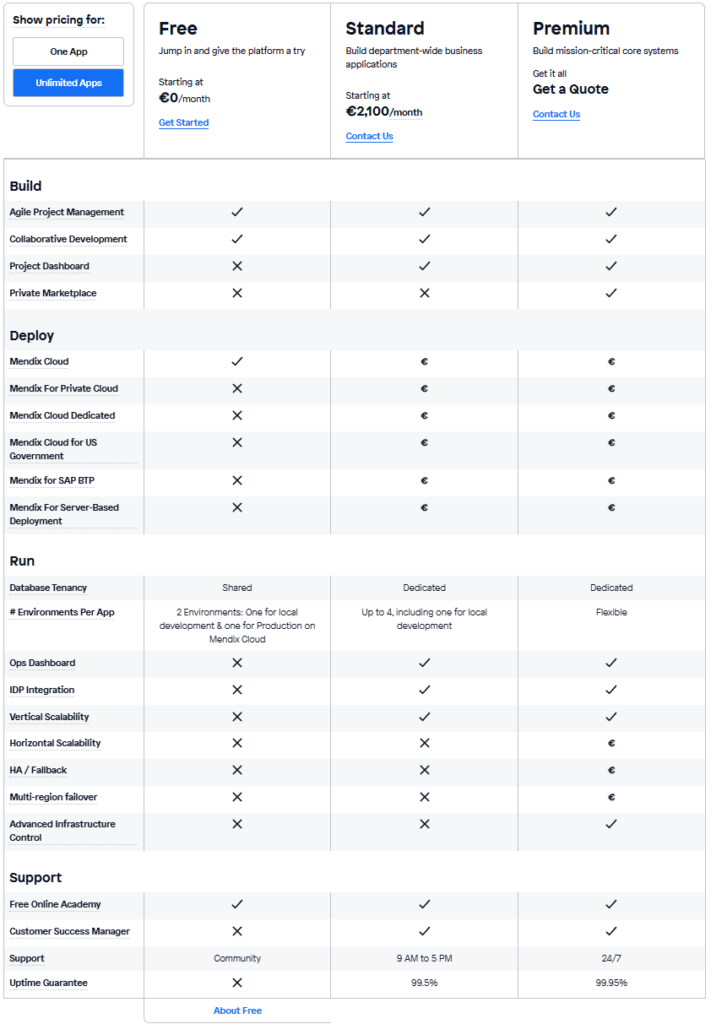Low-code/no-code frameworks have gained popularity in recent years, and this trend is expected to continue. There are many reasons for that, but the chief among them is that software development is very costly and time-consuming, and solutions like Mendix allow you to create apps much faster – and, therefore, cheaper.
Low-code frameworks minimize the amount of coding required to create software and let you include people with less technical know-how (but often a good understanding of business processes) in this process, at least to some degree. No-code technologies take this one step further, allowing for an app development process without any coding whatsoever (though, as you’ll soon find out, this division is no longer that clear). If you want to know more about the current state of the low-code market, feel free to check the analysis of Gartner’s low-code platforms magic quadrant written by our own Przemysław Staniszewski, the CEO of Pretius Low-Code.
Pretius has a long-standing interest in low-code tools. Until recently, we have mostly focused on Oracle APEX but some of our clients didn’t use (or plan to use) Oracle technology. During various meetings and discussions we conducted, they’ve often asked us about our recommendations in their case. We’re always interested in acquiring new skills and competencies, so we’ve started to research – and, when it turned out Mendix was a great answer – invest in and implement the technology. Our developers acquired certificates and learned how to use the solution effectively – and, in the end, we liked it enough to pursue a partnership with Mendix.
This article serves as an introduction to the Mendix low-code development platform – our aim is to provide the readers with a basic understanding of the technology, its advantages, and pricing options. If you’re interested in a technical guide (and creating your very first Mendix app), we also have a comprehensive Mendix tutorial for beginners on our blog.
What is the Mendix platform?

Image source: Mendix.com
Mendix is one of the leading low-code frameworks on the market. It was launched in 2005 by Derek Ross and Derckjan Kruit. Their aim was to create a technology that would allow the rapid development of reactive, high-quality applications that could work in various environments, such as desktop computers, tablets, and smartphones.
Over the years, Mendix found use in many high-profile companies, such as Zurich and Solomon Group. The platform was also used by the city of San Antonio (Texas, USA) to develop an app to speed up the delivery of emergency aid requests during the Covid-19 pandemic – the entire solution was created in just 12 days, which is a testament to how powerful Mendix can really be.
You can use Mendix to create various solutions:
- Native mobile apps (iOS and Android)
- PWAs (Progressive Web Applications) and RWAs (Responsive Web Applications)
- Front-end apps and dashboards connected to other solutions
- Complex tools and systems for internal use
Is Mendix low-code or no-code?
Well, while the answer to this question is simple (low-code), the context is a bit complicated. In the past, the Mendix platform was clearly divided into two different environments:
- Mendix Studio – A no-code solution based on a WYSIWYG (What You See Is What You Get) editor that allows the creation of relatively simple applications without any coding whatsoever. It was a good option for beginners and people without technical knowledge who want to dabble in application development.
- Mendix Studio Pro – a true low-code environment with additional tools and features that offers developers with the necessary technical skills much more flexibility.
However, in June 2023, along with the release of Mendix 10, both IDEs (Integrated Development Environments) were effectively fused into one (the company announced this move half a year earlier). The current incarnation of Mendix is a low-code platform designed for “developers of different skill levels and backgrounds”.
The reasoning behind this decision was quite clear: as low-code and no-code platforms matured as products, the lines between them started to blur. At the same time, people who worked with these frameworks – who didn’t always start out their careers as software developers – acquired new skills and, as they learned, often quickly progressed from Studio to Studio Pro. It also turned out that people with technical knowledge often used no-code tools to expedite their work, and vice versa – users with business background regularly asked for more complex features and options that required some tech savviness.

Mendix vision of the developer spectrum, based on the level of expertise. Source: Mendix.com
Due to these changes, defining low-code and no-code spectrums based on coding affinity alone no longer made sense, and the same could be said about providing two separate IDEs to these increasingly closely interconnected groups. Focusing on one flexible environment was more feasible and allowed for faster development of new features.
Mendix features
Here’s a summary of the most important features offered by the Mendix platform, as highlighted on their website:
- IDE – A single development environment lets people with different skill levels, from citizen developers to experienced programmers, take part in making software.
- AI – Virtual co-developer Mendix Assist Logic Bot streamlines work and allows users to create their solutions easier and faster with the help of Aritificial Intelligence. It can help you configure microflows, and recommend next steps or detect best practice patterns in them. You can also embed ML (machine learning) models into your apps.
- Collaboration – Mendix facilitates team development thanks to useful tools and functionalities such as portfolio management, app insights, and collaborative project spaces. The platform also supports Agile application development and project management and provides built-in tools for this purpose (for example, your don’t need third party solutions like Jira to manage user stories).
- Cloud – Mendix apps are always cloud-native, containerized, and portable, and provide auto-provisioning, low infrastructure overhead, CI/CD support, auto-healing, and cloud interoperability. However, when and how you deploy them, be it on-premise or in public, hybrid, or private cloud, is up to you. If you want to know more, read our “On-premise vs cloud” guide.
- UI/UX – You get consistent UI and UX across different application types (iOS and Android mobile applications, PWAs, web-based portals, etc.) thanks to Mendix’s own UI framework, called Atlas UI, with a bunch of ready-made components that look great and you can use them out-of-the-box, in adherence to the WYSIWYG (What You See Is What You Get) concept.
- Extensibility – You can create reusable Java- and JavaScript-based components for your apps. Integrate various third-party tools, test automation suites, and CI/CD pipelines, and extend the platform functionality with powerful APIs.
- Data – You can access your data easily, visualize it via integrated BI tools, and share it between different teams and projects, thus, ensuring consistency and monitor activity. You design your Domain Model based on Entities (virtual representations of real-world concepts, such as people, places, ideas, etc.) and Mendix builds database structures on top of it.
- Governance – With Mendix, you can also control access levels, and use governance and DevOps tools, built-in testing, automated quality monitoring, and consistency checks.
- Support – Make use of 24/7 support, as well as provided documentation and learning materials, extend apps with extensions downloaded from the Mendix Marketplace, and access the Mendix Forum and community built by thousands of users.
Mendix business advantages
But let’s skip the technical info for now – choosing Mendix as your low-code development environment can also be quite beneficial business-wise. Here are some of the key benefits:
- Accelerated development – As a low-code tool, Mendix allows you to develop solutions at a much faster pace (according to Statista’s poll from 2023, low-code is around 40-60% faster than traditional development, though it’s worth pointing out that some sources cite much higher values).
- Lower costs – When it comes to complex software projects, faster development always equals lower costs.
- Easier collaboration between business and IT – Low-code tools are easier to understand and use by people without technical knowledge, which helps foster collaboration between developers and non-IT specialists. This makes meeting complex business requirements easier. There’s even a term “citizen developer”, which means a non-tech person who uses low-code tools to take an active role in software development.
- Easier talent acquisition – The IT job market changed considerably in recent years, but hiring highly skilled programmers can still be a challenge. Due to the nature of low-code tools such as Mendix, you won’t need as many such specialists, as for a typical software project. Be careful, though, because close-knit cooperation with other departments might require other types of competencies from your people (such as communication skills, etc.).
- Cloud-readiness – Mendix’s native cloud nature means you can take full advantage of a cloud environment, with all its bells and whistles.
Should you want to read more about the benefits of low-code development in general, make sure to check out our article on low-code advantages.
Mendix price – how much does it cost?
You can use Mendix for free, and you get access to the full platform capabilities, community support, and a free online academy. This version allows you to create multi-channel applications (native, web, progressive) and deploy your creations in the Mendix Cloud. It’s a great option for learning purposes or small, personal projects.
However, to get the most out of Mendix – especially in a business environment – you’ll have to pay a subscription fee. The number of available pricing options depends on whether you want to build one app or use the environment for many (unlimited) projects. Here’s what the plans for one app look like at the time of writing this article (August 2024):

Source: Mendix.com
And here are the slightly different options for businesses that want to create more than one software project with Mendix:

Source: Mendix.com
Remember that you can always get up-to-date pricing information on Mendix’s website.
Mendix use cases: What can you create with this technology?
Here are some examples of the diverse scenarios you can cover using Mendix:
- Emergency Aid Application for the city of San Antonio – The government of the city of San Antonio (7th largest such agglomeration in the USA) created a solution that helped speed up the delivery of emergency aid and services (utility, relocation assistance etc.), when demand for such aid spiked during the COVID-19 pandemic. The app optimized the validation process, and improved data visibility for both the applicants, and employees who worked on the requests. The solution processed over a 1,000 requests in the first day alone, and shortened the wait time for aid to 1 week. And the best part? It was made in just 12 days.
- Remaking a key internal application for Zurich – A global insurance corporation, Zurich, used Mendix to recreate an application the company uses to cooperate with its key partner, the reinsurer Pool Re, in order to optimize data entry, integrity, and validation. The software helps customers manage the underwriting process (the verification of income, debt, assets etc. that the lender conducts in order to approve a loan) for terrorism coverage policies which are critical to Zurich’s operations. The team retired legacy technologies (e.g., 2002 SQL Server) and used Mendix to create Terrorism Data Capture (TDC) – a complex application integrated with Salesforce, AWS, Google Maps, local SQL sever database, along with some other APIs and services. The project took 12 weeks to complete and resulted in around £50,000-100,000/app/year operational cost savings for Zurich.
- A custom ERP app and other solutions for Solomon Group – A New Zeland entertainment production company used Mendix to build a brand new, custom ERP system in around 4 months, without help from an outside vendor. The solution allowed them to streamline their operations, link department workflows and organize project information so that it’s easily accessible in one place to every stakeholder. The company liked the end result so much, that the project pushed them to innovate other areas of their business. They started creating various applications, both for internal and external use (for example, designed for specific events and clients). Currently they have 20 such apps in production mode.
Mendix alternatives: What are other low-code platforms you can use?
Mendix, while powerful, won’t be the perfect choice in every scenario. Here are some alternatives to consider:
- Oracle APEX – A flexible low-code platform by Oracle, which is available as a database feature if you already have an Oracle DB license (which means it’s pretty much free in such a case), but you can also use it as a service on the OCI (i.e., Oracle’s cloud service). This alone makes it a great choice for many companies relying on the Oracle ecosystem, but it’s just one of many of APEX’s advantages: it handles data extremely well, offers a great level of security, excellent reporting capabilities, solid backwards compatibility, and plenty of other features. It also evolves really quickly, adding new options and capabilities with each new version.
- Microsoft PowerApps – More no-code than low-code, this is a product created with citizen developers in mind, though it also provides some tools for experienced programmers. You can use PowerApps to make various types of solutions, and it offers a broad range of integration options along with a free IDE. The great thing about PowerApps is that you can access some of the features on a normal 365 or Dynamic 365 enterprise plan. However, in our opinion, the technology is not as flexible as Mendix, APEX, etc..
- OutSystems – A powerful, AI-enhanced low-code platform for general app development, able to create all sorts of software. Its weak point is flexibility and pricing – it’s not the greatest of choices for solving industry-specific problems and after a pricing model change last year it lost a lot of its previous efficiency.
- Appian – Appian focuses on complex logic and workflow capabilities, as well as providing fantastic scalability (it supports container-based deployments, FedRAMP compliance, multi-region high availability, etc.). It’s a great platform if you expect large user volumes, though it’s not cheap.
Summary: Is Mendix a good platform for your business?
And that’s about it. As you can see, Mendix is a pretty powerful solution and can be a great choice for businesses in need of digital transformation. It’ll help you develop applications and systems in record time. It’s one of the most prominent low-code platforms in the world (according to Gartner’s low-code quadrant), offers a powerful, comprehensive feature set, and is supported by a solid team and a thriving community.
For more information on low-code platforms, check out some of the other articles on our blog:
- Oracle APEX tutorial: Uncover Oracle’s best-kept low-code secret
- Oracle APEX new features – the low-code platform keeps evolving
- OutSystems tutorial: Learn low-code development and get your first certificate
- Oracle APEX interview questions 2024: Technical and soft skills you need to have
- APEX 24.1 Working Copies – An in-depth look at one of the platform’s coolest features
And if you need professional support with low-code technology in projects that can’t be achieved without the help of specialized software developers, we’re here just an e-mail away! Write us at hello@pretius.com or use the contact form below – we’ll see what we can do and get back to you in 48 hours.
Mendix platform FAQ
Here are answers to some common questions about Mendix.
What is Mendix?
Mendix is a low-code technology that allows you to create solutions with little to no coding and optimize the application development lifecycle.
What is the current version of Mendix?
The current version of Mendix is 10.12, released in June 2024.
Is Mendix low-code or no-code?
The company behind Mendix characterizes its solution as a low-code platform.
What is Mendix used for?
Mendix is a low-code application development platform that enables organizations to develop many kinds of solutions (including mobile and web apps) quickly. Simple solutions (process automation tools etc.) can be made with little to no coding, but the technology is flexible and allows developers to use their skills to meet more complex requirements and business needs.
Who owns Mendix?
Mendix is owned by Siemens AG.